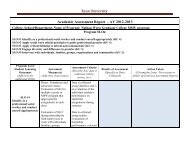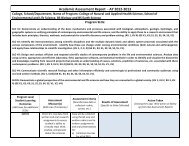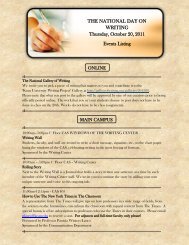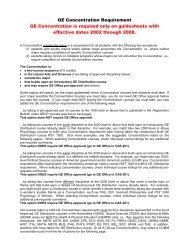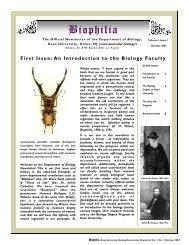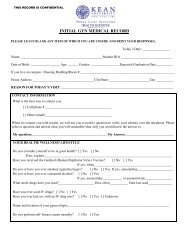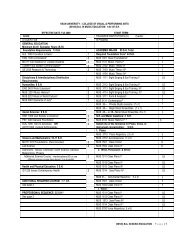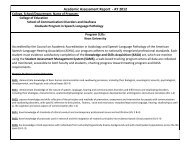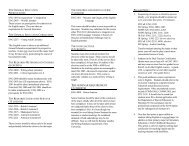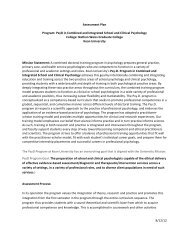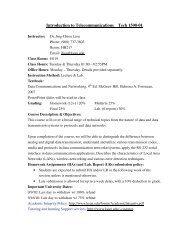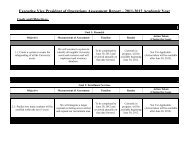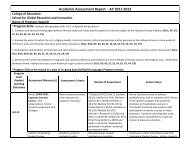Hyoid Bone
Hyoid Bone
Hyoid Bone
Create successful ePaper yourself
Turn your PDF publications into a flip-book with our unique Google optimized e-Paper software.
<strong>Hyoid</strong> <strong>Bone</strong><br />
Lies just inferior to the mandible in the anterior neck<br />
Only bone of the body that does not articulate directly with<br />
another bone<br />
Anchored by stylohyoid ligaments to the styloid processes of<br />
the temporal bones<br />
Acts as a movable base for the tongue<br />
Body & horns (cornu) are points of muscle attachment that raise<br />
and lower the larynx during swallowing and speech.<br />
Copyright © 2006 Pearson Education, Inc., publishing as Benjamin Cummings
Copyright © 2006 Pearson Education, Inc., publishing as Benjamin Cummings
Vertebral Column<br />
Formed from 26 irregular bones (vertebrae) connected in such a way that<br />
a flexible curved structure results<br />
Axial support of the trunk (skull to pelvis)<br />
Surrounds / protects the spinal cord<br />
Attachment point for the ribs and muscles<br />
Fetus: 33 bones, 9 fused to form 2 composite bones: the coccyx and<br />
sacrum<br />
Cervical vertebrae – 7 bones of the neck<br />
Thoracic vertebrae – 12 bones of the torso<br />
Lumbar vertebrae – 5 bones of the lower back<br />
Sacrum – bone inferior to the lumbar vertebrae that articulates with the<br />
hip bones<br />
Copyright © 2006 Pearson Education, Inc., publishing as Benjamin Cummings
Vertebral Column<br />
Cervical vertebrae – 7 bones of the neck<br />
Thoracic vertebrae – 12 bones of the torso<br />
Lumbar vertebrae – 5 bones of the lower back<br />
Sacrum – bone inferior to the lumbar vertebrae that<br />
articulates with the hip bones<br />
Coccyx – articulates with the sacrum:<br />
TOTAL = 26<br />
Copyright © 2006 Pearson Education, Inc., publishing as Benjamin Cummings
Vertebral Column<br />
Copyright © 2006 Pearson Education, Inc., publishing as Benjamin Cummings<br />
Figure 7.13
Vertebral Column: Curvatures<br />
Posteriorly concave curvatures – cervical and<br />
lumbar<br />
Posteriorly convex curvatures – thoracic and sacral<br />
Abnormal spine curvatures include scoliosis<br />
(abnormal lateral curve), kyphosis (hunchback),<br />
and lordosis (swayback)<br />
Copyright © 2006 Pearson Education, Inc., publishing as Benjamin Cummings
Vertebral Column: Ligaments<br />
Major supporting ligaments are: Anterior and Posterior<br />
Continuous bands down the front and back of the spine from the cervical<br />
vertebrae to the sacrum<br />
Anterior longitudinal ligaments:<br />
Broad, resists bending backwards attached to both the vertebrae and<br />
the discs<br />
Posterior longitudinal ligaments<br />
Not as broad, resists bending forward, attaches only to discs<br />
Ligamentum flavum:<br />
Connect vertebra above and below.<br />
Elastic consistency and strong<br />
Copyright © 2006 Pearson Education, Inc., publishing as Benjamin Cummings
Ligamentum Flava Flavum<br />
Copyright © 2006 Pearson Education, Inc., publishing as Benjamin Cummings
Vertebral Column: Intervertebral Discs<br />
Cushion-like pad composed of two parts<br />
Nucleus pulposus – inner gelatinous nucleus that gives the<br />
disc its elasticity and compressibility<br />
Annulus fibrosus – surrounds the nucleus pulposus with a<br />
collar composed of collagen fibers (superficially) and<br />
fibrocartilage (internally)<br />
Limits the expansion of the nucleus pulposus when the<br />
spine is compressed<br />
Binds successive vertebrae together<br />
Copyright © 2006 Pearson Education, Inc., publishing as Benjamin Cummings
General Structure of Vertebrae<br />
Body or centrum – (anteriorly)<br />
disc-shaped, weight-bearing region<br />
Vertebral arch – (posteriorly)<br />
composed of pedicles and laminae that, along<br />
with the centrum, enclose the vertebral foramen<br />
Vertebral foramina – make up the vertebral canal<br />
through which the spinal cord passes<br />
Copyright © 2006 Pearson Education, Inc., publishing as Benjamin Cummings
Bony Thorax (Thoracic Cage)<br />
Functions<br />
Forms a protective cage around the heart, lungs,<br />
and great blood vessels<br />
Supports the shoulder girdles and upper limbs<br />
Provides attachment for many neck, back, chest,<br />
and shoulder muscles<br />
Uses intercostal muscles to lift and depress the<br />
thorax during breathing<br />
Copyright © 2006 Pearson Education, Inc., publishing as Benjamin Cummings
Copyright © 2006 Pearson Education, Inc., publishing as Benjamin Cummings
Sternum (Breastbone)<br />
A dagger-shaped, flat bone that lies in the anterior<br />
midline of the thorax<br />
Results from the fusion of three bones – the<br />
superior manubrium, the body, and the inferior<br />
xiphoid process<br />
Copyright © 2006 Pearson Education, Inc., publishing as Benjamin Cummings
Sternum (Breastbone)<br />
Manubrium:<br />
Body:<br />
Articulates via clavicular notches with clavilcles<br />
laterally<br />
Articulates with the first 2 rib pairs<br />
Articulates with cartilage of the 2 nd -7 th ribs<br />
Xiphoid process:<br />
Articulates with the sternal body and attachment point<br />
for some abdominal muscles<br />
Copyright © 2006 Pearson Education, Inc., publishing as Benjamin Cummings
Sternum (Breastbone)<br />
Anatomical landmarks: CAN PALPATE ALL OF ‘EM<br />
jugular (suprasternal) notch:<br />
sternal angle:<br />
Superior border of the maubrium<br />
In line with T2-T3 intersection<br />
Point where left common carotid artery splits from the aorta<br />
Hinge<br />
Allows sternal body to move forward upon inhalation<br />
Inline with T4-T5 intersection<br />
Inline with 2 nd pair of ribs<br />
xiphisternal joint:<br />
Lies opposite T9<br />
Copyright © 2006 Pearson Education, Inc., publishing as Benjamin Cummings
Ribs<br />
Copyright © 2006 Pearson Education, Inc., publishing as Benjamin Cummings<br />
Figure 7.19a
Gimme some of them Ribs!<br />
There are twelve pair of ribs forming the flaring sides of the thoracic cage<br />
All ribs attach posteriorly to the thoracic vertebrae<br />
The superior 7 pair (true, or vertebrosternal ribs) attach directly to the<br />
sternum via costal cartilages<br />
Ribs 8-10 (false, or vertebrochondral ribs) attach indirectly to the sternum<br />
via costal cartilage (or not at all)<br />
Each joins the costal cartilage immediately above it<br />
Costal margin: inferior margin of the rib cage<br />
Formed by costal cartilage of ribs 7-10<br />
Ribs 11-12 (floating, or vertebral ribs) have no anterior attachment<br />
Copyright © 2006 Pearson Education, Inc., publishing as Benjamin Cummings
Appendicular Skeleton<br />
The appendicular skeleton is made up of the bones<br />
of the limbs and their girdles<br />
Pectoral girdles attach the upper limbs to the body<br />
trunk<br />
Pelvic girdle secures the lower limbs<br />
Copyright © 2006 Pearson Education, Inc., publishing as Benjamin Cummings
Pectoral Girdles (Shoulder Girdles)<br />
Copyright © 2006 Pearson Education, Inc., publishing as Benjamin Cummings<br />
Figure 7.22a
Pectoral Girdles (Shoulder Girdles)<br />
The pectoral girdles consist of:<br />
Clavicle anteriorly & scapula posteriorly<br />
Anteriorly, the medial end of each clavicle joins the sternum<br />
The distal ends of the clavicle meet the scapulae laterally<br />
The scapulae are attached to the thorax & vertebral column by muscles<br />
The clavicle and scapula are light weight and very mobile<br />
However, there is a price to pay…greater mobility means poor stability<br />
often resulted in a painful dislocated shoulder<br />
Copyright © 2006 Pearson Education, Inc., publishing as Benjamin Cummings
Clavicles (Collarbones)<br />
The acromial (lateral) end articulates with the scapula, and the sternal<br />
(medial) end articulates with the sternum<br />
The superior surface is smooth while the inferior surface is ridged and<br />
grooved by ligaments<br />
Provide attachment points for numerous muscles, and act as braces to hold<br />
the scapulae and arms out laterally away from the body<br />
The clavicles transmit compression force from the upper limbs to the axial<br />
skeleton<br />
Copyright © 2006 Pearson Education, Inc., publishing as Benjamin Cummings
Scapulae (Shoulder Blades)<br />
The posterior surface of the scapula has a prominent spine (palpate)<br />
The spine terminates laterally at the acromion process<br />
The acromion articulates with the acromial end of the clavicle forming the<br />
acromioclavicular joint<br />
The coracoid process anchors the biceps<br />
The suprascapoid notch allows a passage way for nerves<br />
The infraspinous, supraspinous, subscapular fossae are sites for muscle<br />
attachment (later this semester)<br />
Copyright © 2006 Pearson Education, Inc., publishing as Benjamin Cummings
Copyright © 2006 Pearson Education, Inc., publishing as Benjamin Cummings
KU Game Week!!!!<br />
Thur. 7 pm<br />
Sat. 10 am<br />
Sat. 11 am<br />
Sat. 2 pm<br />
Sat. 7 pm<br />
Sun. 1 pm<br />
Copyright © 2006 Pearson Education, Inc., publishing as Benjamin Cummings



